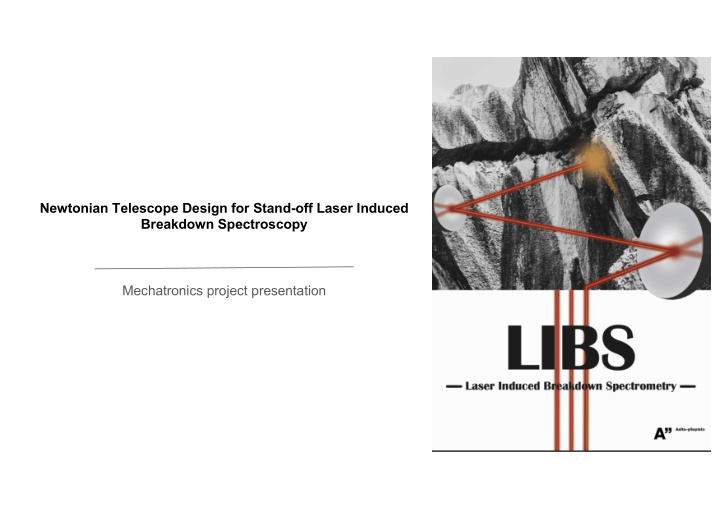



Newtonian Telescope Design for Stand-off Laser Induced Breakdown Spectroscopy Mechatronics project presentation
What is LIBS? ● LIBS stands for Laser Induced Breakdown Spectroscopy ● LIBS focuses a laser onto a sample which results in ablation (plasma forming) ● Light is gathered from the plasma and analyzed ● Stand-off LIBS means that the range to the sample varies. ● Most common applications: ○ Detecting explosive materials from a distance (Military) ○ Testing element compositions of samples in Mars Rover (Research) ○ Mapping out elements in mine walls in mining operations (Commercial)
What is LIBS?
Research goals and initial prototype ● The goal was to improve the initial prototype: ○ To gather enough light for a high quality spectroscopy analyze. ○ The device should function properly in the range of 3 - 10 meters. ○ The wavelength gathered for the spectrometer should include the ranges of 200 - 950 nm. ○ The laser beam focused onto the sample should be on the same optical axis as the light gathering optical components, to prevent complexity of the light path. ○ Minimizing the area of the components on the breadboard. ○ Enlarging the lenses for the laser beam to enable less power from the laser.
Our solution ● Modified Newtonian telescope that uses primary concave mirror and 45 degree secondary mirror to collect the light. ● Laser is steered to the same optical axis in front of the telescope ● The stepper motors that focus the laser and the fibre optic are outside the telescope and the optical axis
Prototyping ● 3D-printing as main manufacturing method ○ + Allows very free design ○ + Relatively fast, cheap and easy ○ - Poor tolerances compared to machining ● Laser cutting for specific parts ○ + Good tolerances ○ + Strong and stiff ○ + Very fast ○ - Only flat geometry
Quantel Q-smart 450 Optical components pulsed Nd:YAG laser system 0.5” negative lens For the laser path 2” gold plated 45 degree mirror for the laser path
Tests ● The expanding and focusing lenses functionalities were tested with a laser pointer. ● The best focus was tested by moving the expanding lens, as well as the target sample.
Results Main findings: - Newtonian telescope is the optimal setup for this 3D printed components for the modified Newtonian telescope application - Setup can be built using 3D printed parts - the light gathering area of the primary mirror is 5.9x the original prototypes Usable mirror area in blue
Thank you Questions?
Recommend
More recommend